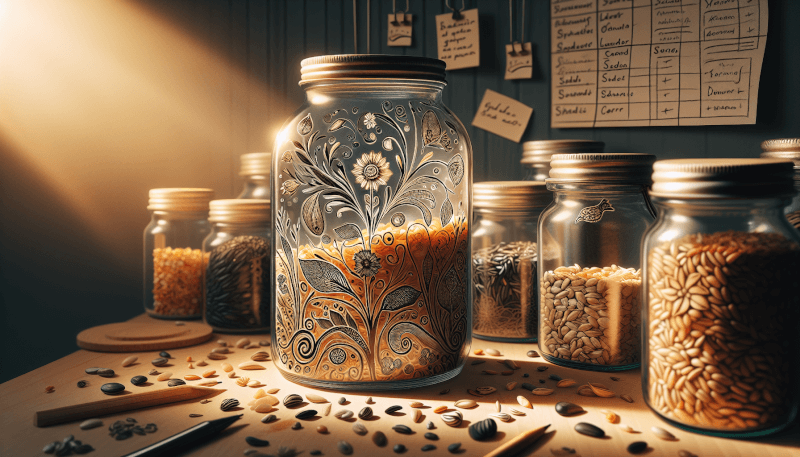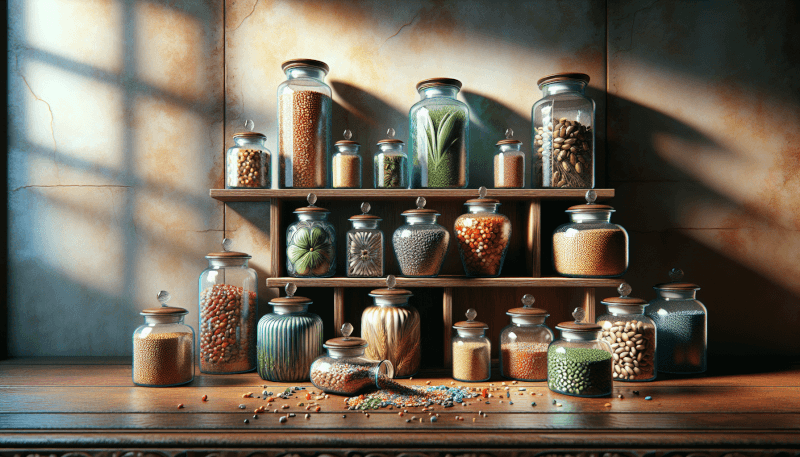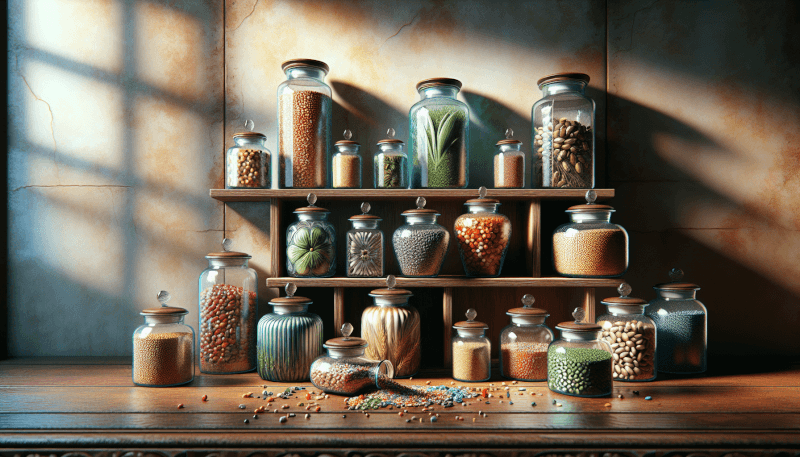Are you tired of your seeds being scattered all over the place or stored in plain, boring containers? Look no further than the Seed Jar, a stunning and practical solution to store and organize your precious seeds. Designed with both functionality and aesthetics in mind, this jar not only keeps your seeds safe and secure, but it also adds a touch of beauty to your gardening routine. With its transparent glass body and airtight lid, the Seed Jar not only allows you to easily see and access your seeds, but it also helps to maintain their freshness for longer periods. Say goodbye to messy seed storage and embrace the elegance of the Seed Jar; your gardening experience will never be the same again.

Choosing the Right Seed Jar
Glass or Plastic?
When it comes to choosing the right seed jar, one of the first decisions you’ll need to make is whether to opt for a glass or plastic container. Glass jars have the advantage of being sturdy and durable, which is important for protecting your seeds. They are also transparent, allowing you to easily see the contents inside. On the other hand, plastic jars are lightweight and less prone to breaking, making them a more practical choice if you plan on moving or transporting your seeds frequently.
Size and Capacity
Another important consideration when choosing a seed jar is its size and capacity. You’ll want to select a jar that is large enough to accommodate your seed collection, both in terms of quantity and variety. Aim for a jar with a capacity that allows for sufficient airflow around the seeds, preventing moisture buildup and mold growth. Additionally, consider the available space you have for storage and choose a size that fits your needs.
Lid Type and Seal
The type of lid and seal on your seed jar can greatly impact its effectiveness in preserving the viability of your seeds. Look for a jar with an airtight seal to prevent moisture and pests from entering. A screw-on lid or a jar with a rubber gasket can provide a secure closure, ensuring that your seeds stay dry and protected. It’s also worth considering a jar with a lid that is easy to open and close, as this will make accessing your seeds a breeze.
Transparency and Visibility
The transparency of your seed jar is not only aesthetically pleasing but also practical. Being able to see the contents of your jar at a glance makes it easier to locate and select the seeds you need. Additionally, transparent jars allow natural light to reach the seeds, which can be beneficial for some varieties that require light for germination. Consider opting for a clear glass jar or a plastic container that offers good visibility for an easier and more organized seed storage experience.
Preparing the Seed Jar
Cleaning the Jar
Before using your new seed jar, it is essential to clean it thoroughly. Even if it appears clean, residue or debris may be present, which can contaminate your seeds. Wash the jar with warm water and mild soap, making sure to rinse it thoroughly to remove any soap residue. Avoid using harsh chemicals or abrasive materials that could damage the jar’s surface. Once cleaned, allow the jar to dry completely before proceeding to the next step.
Sterilizing the Jar
To ensure the best conditions for seed preservation and prevent the growth of mold or fungi, sterilizing the jar is highly recommended. You can do this by placing the jar in a pot of boiling water for a few minutes. Alternatively, you can use a dishwasher set to a high-temperature setting. This step will help eliminate any potential pathogens that could harm the seeds. Remember to allow the jar to cool completely before handling it to avoid burns.
Labeling the Jar
Labeling your seed jar is an important step in staying organized and easily identifying the seeds stored inside. Use a waterproof marker or a label maker to clearly indicate the name, variety, and date of collection for each type of seed. You may also add any additional relevant information, such as special instructions for germination or any specific growing conditions. This will prevent confusion and make it easier to find the seeds you’re looking for in the future.
Storing Seeds in the Seed Jar
Collecting Seeds
When it comes to collecting seeds for storage, wait until they are fully mature and dry on the plant. Harvest the seeds in the morning when the plants are dry, as excess moisture can affect their viability. Remove any debris or chaff from the seeds, ensuring that they are clean and free from any mold or pests. Place the seeds in a paper bag or envelope until you are ready to transfer them to the seed jar.
Drying Seeds
Before storing the seeds in the seed jar, it is essential to ensure they are completely dry. Moisture is one of the biggest threats to the longevity of seeds, as it can lead to mold or decay. Spread the seeds out in a single layer on a clean, dry surface, such as a paper towel or a tray lined with parchment paper. Allow them to air dry for several days until they are crisp and no longer pliable. This step will help prolong the viability of the seeds during storage.
Sorting and Cleaning Seeds
Once the seeds are dry, it’s time to sort and clean them before placing them in the seed jar. Remove any damaged or discolored seeds, as they are likely to be non-viable. Additionally, remove any remaining plant material or debris that may have been collected during the harvesting process. Use a fine mesh sieve or a seed-cleaning screen to separate the seeds from any chaff or small particles. This step ensures that only clean and viable seeds make it into the seed jar.

Organizing Seeds in the Seed Jar
Categorizing Seeds
Organizing your seeds based on categories can make it easier to locate and retrieve specific varieties when needed. You can categorize them by plant type, such as vegetables, herbs, flowers, or by specific characteristics like sun-loving or shade-tolerant plants. Choose a system that makes sense to you and aligns with your gardening needs. By categorizing your seeds, you’ll be able to maintain a more orderly and efficient seed jar.
Using Dividers or Compartments
For further organization within the seed jar, consider using dividers or compartments. These can help keep different categories of seeds separate, preventing them from mixing or becoming disorganized over time. You can create dividers using materials such as cardboard, plastic, or even recycled containers. Ensure that the dividers fit securely in the jar to prevent any seeds from spilling or mixing unintentionally. This additional level of organization will save you time and effort when searching for specific seeds.
Creating Alphabetical or Numerical Order
Another option for organizing seeds within the seed jar is to arrange them in either alphabetical or numerical order. This approach can be particularly helpful if you have a large collection of seeds or want to keep track of newly added varieties. Assign a letter or number to each category or type of seed, and label the corresponding dividers or sections in the jar. This method allows for easy navigation and ensures that your seed jar remains neatly arranged.
Maintaining the Seed Jar
Checking for Moisture
Regularly checking for moisture inside the seed jar is essential to prevent any potential damage or mold growth. Moisture can occur due to residual moisture on the seeds or from condensation inside the jar. Open the jar periodically to allow fresh air to circulate and check for any signs of dampness. If moisture is present, remove the seeds and allow them to air dry before returning them to the jar. This simple step will help maintain the longevity of your seeds.
Inspecting for Pests
Pests can pose a significant threat to the viability of stored seeds. Regularly inspect your seed jar for any signs of infestation, such as small holes, webs, or the presence of live insects. If you detect any pests, remove the affected seeds and dispose of them properly to prevent further contamination. Consider placing a small packet of desiccant or a dried bay leaf in the seed jar to deter pests. This proactive approach will help safeguard your cherished seed collection.
Rotating Seeds
To maintain the viability of your stored seeds, it’s wise to practice seed rotation within the seed jar. Seeds have varying lifespans, and some may lose viability faster than others. By periodically rotating the seeds, you ensure that you use the oldest seeds first while preserving the freshness of the newer additions. Consider moving seeds from the back of the jar to the front or creating a system that allows you to easily keep track of the rotation. This practice will help prevent any seeds from languishing and going to waste.
Replacing Jar Components
Over time, the components of your seed jar, such as the lid or dividers, may become worn or damaged. It’s important to regularly inspect and replace any components as needed to ensure the continued effectiveness of the seed jar. If the lid no longer provides a tight seal or the dividers become loose or unstable, consider purchasing replacement parts or investing in a new jar altogether. By maintaining the integrity of the seed jar, you can confidently protect and manage your seed collection.
Benefits of Using a Seed Jar
Preserving Seed Viability
Arguably the most significant benefit of using a seed jar is the preservation of seed viability. The right jar, along with proper storage techniques, can extend the lifespan of your seeds, allowing you to use them for multiple growing seasons. By keeping them dry, protected from pests, and organized, you maximize the chances of successful germination and bountiful harvests year after year.
Easier Seed Selection
Storing your seeds in a seed jar provides the convenience of easy seed selection. With a well-organized and labeled jar, you can quickly locate the specific seed variety you need, saving time and effort. No more rummaging through various seed packets or searching for misplaced envelopes. The clear visibility and accessibility of seeds in a jar make the process of seed selection a breeze.
Reducing Seed Waste
By storing your seeds in a seed jar, you reduce the chances of seeds going to waste. The carefully controlled environment of the seed jar maintains the viability of the seeds, preventing premature aging or germination. With proper organization and rotation, you can utilize your entire seed collection efficiently, minimizing waste and ensuring that no seed gets overlooked or forgotten.
Decorative and Aesthetic Appeal
Beyond the functionality, using a seed jar adds a touch of beauty and aesthetics to your gardening space. Glass jars, especially if artistically decorated or paired with vintage labels, can become exquisite additions to your home or garden decor. Displaying your seed jar becomes a visual reminder of the life and abundance contained within. The seed jar serves not only as a storage solution but also as a captivating piece of art.
Potential Drawbacks of the Seed Jar
Limited Storage Capacity
Although seed jars offer a stylish and organized approach to seed storage, one potential drawback is their limited storage capacity. Depending on the size of your seed collection, a seed jar may not accommodate all your seeds in one container. This limitation may require you to have multiple seed jars or to consider alternative storage options for any overflow of seeds. Assess the size of your collection and ensure you have sufficient space to house all your seeds before committing to a seed jar.
Risk of Moisture Damage
Seed jars can be susceptible to moisture damage if not properly maintained. Condensation or moisture buildup inside the jar can compromise the seed’s viability and lead to mold growth. It is crucial to regularly monitor the seed jar for any signs of moisture and take prompt action to remedy the situation. With proper care and attention, however, the risk of moisture damage can be minimized or eliminated entirely.
Limited Visibility of Seeds
While the transparent nature of seed jars is advantageous in many ways, it does come with one potential downside: limited visibility of seeds. If the jar becomes overcrowded or the seeds are small or located at the bottom, it may be challenging to see and access them easily. This limitation may necessitate pouring out the seeds or shifting them around to locate the desired variety. Consider opting for a jar with dividers or compartments to mitigate this issue and keep your seeds neatly organized.
Creative Ideas for Seed Jar Labeling and Decoration
Using Calligraphy or Handwriting
Add a personal and artistic touch to your seed jar by using calligraphy or your own handwriting for labeling. Choose a waterproof pen or marker and experiment with different lettering styles and colors to create a visually appealing label. This approach not only serves a functional purpose but also adds a unique and decorative element to your seed jar.
Incorporating Seed Packets or Pictures
For a charming and nostalgic touch, consider incorporating seed packets or pictures into your seed jar. Attach small envelopes containing seeds to the outside of the jar, or photocopy colorful images of the plants the seeds will grow into and place them inside the jar for a delightful surprise when opening it. This creative and whimsical addition will add character and personality to your seed storage.
Painting or Decorating the Jar
Unleash your creativity by painting or decorating your seed jar to make it truly unique. Choose a color scheme that complements your gardening space or opt for intricate designs and patterns to give your jar a personalized touch. You can use acrylic paints, glass paint markers, or even decoupage techniques to achieve the desired effect. The result will be a one-of-a-kind seed jar that reflects your style and creativity.
Alternatives to the Seed Jar
Seed Envelopes
Seed envelopes are a classic and widely used alternative to the seed jar. They are lightweight, portable, and allow for easy seed organization and labeling. Seed envelopes also provide good air circulation, preventing moisture buildup and mold. They are especially helpful if you have a large seed collection or if you need to transport seeds frequently. However, keep in mind that seed envelopes may not offer the same level of protection against pests and breakage as a seed jar.
Seed Tins
Seed tins are another popular option for storing and organizing seeds. They are typically made of metal, which provides excellent protection against moisture, pests, and breakage. Just like seed jars, seed tins can be labeled and organized to your liking, ensuring easy seed selection. However, they may not offer the same aesthetic appeal as a glass jar and may have limited visibility of the seeds inside.
Seed Cases
If you prefer a more compact and portable seed storage solution, consider using a seed case. These cases are designed specifically for storing small quantities of seeds and often come with dividers or compartments to keep different varieties separate. Seed cases are lightweight, durable, and often have a secure latch to keep the seeds safe. They are ideal for keeping a small selection of seeds with you while on the go or for those with limited storage space.
Conclusion
Choosing the right seed jar, preparing it for use, storing and organizing seeds, and maintaining its condition are all crucial steps in creating a well-managed and efficient seed collection. While there are various alternatives to the seed jar, it offers unique benefits such as preserving seed viability, easy seed selection, and reducing seed waste. However, it’s vital to be mindful of its limitations, including limited storage capacity and the need for regular moisture and pest checks. With careful consideration and proper maintenance, a seed jar can serve as an invaluable tool in your garden, providing an organized and visually appealing way to store and access your seeds.




